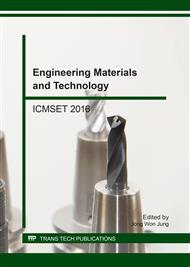[1]
K. Watanabe, M. Sakairi, H. Takahashi, Anodizing of aluminum coated with silicon oxide by a sol–gel method, J. Electrochem. Soc. 148 (2001) B473–B481.
DOI: 10.1149/1.1408633
Google Scholar
[2]
X. F. Du, Y. L. Xu, Formation of Al2O3–Bi4Ti3O12 nanocomposite oxide films on low-voltage etched aluminum foil by sol–gel processing, Surf. Coat. Tech. 202 (2008) 1923–(1927).
DOI: 10.1016/j.surfcoat.2007.08.020
Google Scholar
[3]
S. S. Park, B. T. Lee, Anodizing properties of high dielectric oxide films coated on aluminum by sol–gel method, J. Electroceram. 13 (2004) 111–116.
DOI: 10.1007/s10832-004-5085-z
Google Scholar
[4]
K. Watanabe, M. Sakairi, H. Takahashi, Formation of Al–Zr composite oxide films on aluminum by sol–gel coating and anodizing, J. Electroanal. Chem. 473 (1999) 250–255.
DOI: 10.1016/s0022-0728(99)00121-7
Google Scholar
[5]
J. J. Chen, Z. S. Feng, M. L. Jiang, The effect of anodizing voltage on the electrical properties of Al–Ti composite oxide film on aluminum, J. Electroanal. Chem. 590 (2006) 26–31.
DOI: 10.1016/j.jelechem.2006.02.016
Google Scholar
[6]
F. Chen, S. S. Park, Formation behavior of multi-layer oxide films on etched Al foil by vacuum infiltration and anodization, ECS J. Solid State Sci. Technol. 4 (2015) P293–P297.
DOI: 10.1149/2.0051508jss
Google Scholar
[7]
M. Sunada, H. Takahashi, T. Kikuchi, Dielectric properties of Al–Si composite oxide films formed on electropolished and DC-etched aluminum by electrophoretic sol-gel coating and anodizing, J. Solid State Electrochem. 11 (2007) 1375–1384.
DOI: 10.1007/s10008-007-0316-2
Google Scholar
[8]
J. H. Jang, W. S. Choi, S. H. Lee, Fabrication and characterization of a thin film capacitor using Al anodizing and Ni electroless plating, Scripta Materialia 63 (2010) 269–272.
DOI: 10.1016/j.scriptamat.2010.04.004
Google Scholar
[9]
J. H. Liu, Q. Guo, M. Yu, Effect of TiO2 nanostructures on specific capacitance of Al2O3–TiO2 composite film on etched aluminum foil formed by the sol–gel and anodizing, Ceram. Int. 40 (2014) 3687–3692.
DOI: 10.1016/j.ceramint.2013.09.056
Google Scholar
[10]
X. F. Du, K. Men, Y. L. Xu, Enhanced capacitance performance of Al2O3–TiO2 composite thin film via sol–gel using double chelators, J. Colloid Interf. Sci. 443 (2015) 170–176.
DOI: 10.1016/j.jcis.2014.11.038
Google Scholar
[11]
L. Sun, J. F. Bu, W. X. Guo, Electrophoresis deposition of TiO2 nanoparticles on etched aluminum foil for enhanced specific capacitance, Electrochem. Solid-State Lett. 15 (2011) E1–E3.
DOI: 10.1149/2.013201esl
Google Scholar
[12]
J. F. Bu, L. Sun, Q. Wu, Al2O3–TiO2 composite oxide films on etched aluminum foil fabricated by electrodeposition and anodization, Sci. China Chem. 54 (2011) 1558–1564.
DOI: 10.1007/s11426-011-4377-9
Google Scholar
[13]
J. J. Chen, Z. S. Feng, B. C. Yang, Al2O3–TiO2 composite oxide films on etched aluminum foil by hydrolysis precipitation and anodizing, J. Mater. Sci. 41 (2006) 569–571.
DOI: 10.1007/s10853-005-2507-5
Google Scholar
[14]
L. Xiang, S. S. Park, Preparation of titanium dioxide films on etched aluminum foil by vacuum infiltration and anodizing, Appl. Sruf. Sci. 388 (2016) 245–251.
DOI: 10.1016/j.apsusc.2016.01.166
Google Scholar
[15]
L. Yao, J. H. Liu, M. Yu, Formation and capacitance properties of Ti–Al composite oxide film on aluminum, Trans. Nonferrous Met. Soc. China. 20 (2010) 825–830.
DOI: 10.1016/s1003-6326(09)60221-1
Google Scholar
[16]
R. S. Alwitt, C. K. Dyer, B. Noble, Voids in anodic aluminum oxide films, J. Electrochem. Soc. 129 (1982) 711–717.
DOI: 10.1149/1.2123956
Google Scholar
[17]
J. Yu, X. Zhao, Q. Zhao, Effect of film thickness on the grain size and photocatalytic activity of the sol–gel derived nanometer TiO2 thin films, J. Mater. Sci. Lett. 19 (2000) 1015–1017.
Google Scholar
[18]
L. H. Liu, Q. Guo, M. Yu, Formation and dielectric properties of Al-Ti-O nanocomposite oxide film on aluminum using sol–gel and anodizing, ECS J. Solid State Sci. Technol, 2 (2013) N55–N60.
DOI: 10.1149/2.007303jss
Google Scholar


